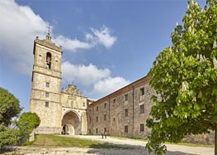
Locality: AYEGUI (31240)
Address: Monasterio de Irache
Zone: The Central Zone
Style: Romanesque
Centuries of construction: XI
Tel.: 948554464
History
A pilgrims’ hospice, university, military hospital, religious college and, in the future, a Parador. These are the different functions that the Monastery of Irache has performed down the years, which have turned it into one of the most important monumental complexes in Navarre.
Location
Its location, on the Pilgrim’s Way to Santiago de Compostela near Estella, has made it an obligatory stopping-place for pilgrims and friends of the Pilgrim’s Way, who you will see during your visit to this monastery that the Benedictines started building in the second half of the 11th century on top of another older one from the 8th century.
Description
A tour of the Romanesque church (12th century), the Plateresque cloister, the Herrerian-style tower and other sections built between the sixteenth and nineteenth centuries will give you an insight to the history of this monumental construction, which has been uninhabited since 1985.
Built in the shelter of the mountain of Montejurra in Ayegui, just two kilometres from Estella and surrounded by vineyards, the Monastery of Irache initially appears to visitors as an immense mass of Medieval, Renaissance and Baroque buildings.
It was the first pilgrims’ hospice in Navarre (the Orreaga/Roncesvalles hospice was not built until a century later) and it was constructed on the orders of King García ?el de Nájera’ (11th century).
Its golden age coincided with the years during which San Veremundo was the Abbott (1056-1098); he was so charitable to the poor that he used to take them food concealed under his habit. Whenever his brothers used to reproach him, he would lift up his habit and roses or wooden chips would appear instead of bread so the beggars could warm themselves.
The monastery, which was dedicated to Santa María la Real, was continually inhabited, which meant that it was kept in a very good condition. In 1985, however, the lack of vocations caused the monks to depart and since then it has been uninhabited. The complex housed a University between 1569 and 1824.
L’Intérieur
Entrance to the monastery is free of charge and the most stunning sight of the complex is the Romanesque church, which was started in the 12th century over the remains of a previous pre-Romanesque church.
It is laid out in the shape of a Latin cross and has three semicircular apses, evidence of primitive construction, of which the central apse is notable for its perfectly-preserved cornice adorned with animals.
You can enter the church through two Romanesque doorways, St. Peter’s door (the main door), which is carved with historical motifs: It is also worth stopping to have a look at the Preciosa door which links the Plateresque cloister with the church and features images of the Saviour and the Virgin Mary.
The monastic sacristy (16th century), the chapterhouse with its ribbed vault and a large building dating from the beginning of the seventeenth century which used to house the University of Irache are also well worth a visit.
The monastery, which has a new cloister, holds more than 7,000 pieces of art and ethnographic items and a collection of carriages displayed in the monastery’s passageways. For centuries, it housed the image of Our Lady of Irache (12th century), one of the most beautiful examples of Marian Romanesque imagery in Navarre. Made of wood, it stands one metre high and is covered with silver plate, except for the face and hands. If you would like to admire her, however, you will need to go to the church of Dicastillo, around 10 kilometres to the south of Ayegui, where she has been kept for the last century.
Next to the monastery is a fountain which pours water from one spout and wine from the other, with the aim of sating the thirst and cheering the progress of the pilgrims. The fountain belongs to the Bodegas Irache winery, which stands next to the monastery, where you can take a guided tour.







